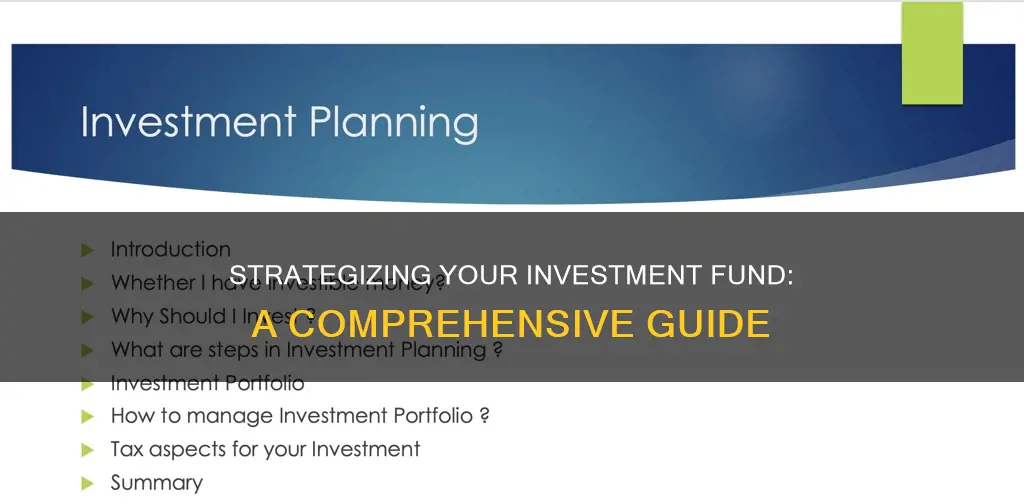
Planning an investment fund can be a challenging task, but with the right approach, it becomes more manageable. The first step is to assess your current financial situation, including income, expenses, debt, and emergency funds. Then, it's crucial to define clear goals and a timeline for your investments. Are you investing for retirement, generating passive income, or creating generational wealth? Knowing your risk tolerance is also essential, as it guides your investment choices.
Once you've established these fundamentals, it's time to decide on the types of investments that align with your goals and risk appetite. Common options include stocks, bonds, mutual funds, and exchange-traded funds (ETFs). It's generally recommended to diversify your portfolio to minimise risk.
As you build your investment plan, keep fees and taxes in mind, as they can eat into your returns. Finally, consider seeking advice from qualified financial advisors to ensure your plan is tailored to your specific needs and goals.
What You'll Learn

Evaluate your current financial standing
Evaluating your current financial standing is a critical step in creating an investment plan. This involves taking stock of various aspects of your finances to determine how much you can invest.
Firstly, consider your income and expenses. Understand how much disposable income you have available to invest by evaluating your budget and determining the money left over after monthly expenses. This includes essential living expenses, such as rent or mortgage payments, utilities, groceries, and transportation costs. It is also crucial to have an emergency fund equivalent to three to six months' worth of expenses set aside before investing.
Next, assess your debt. Calculate your total debt and evaluate whether it has increased or decreased over the past year. Additionally, reflect on whether you have borrowed money in the last 12 months. Reducing debt is essential for financial stability, so consider ways to minimize new debt and accelerate debt repayment.
Another aspect of your financial standing is your retirement planning. Evaluate whether you are on track to meet your retirement goals by assessing your contributions to retirement accounts, such as a 401(k) or IRA. Ensure you are maximizing your investments in these accounts to prepare for the future.
Your credit score and report are also essential factors. Regularly review your credit report to detect any discrepancies or signs of identity theft. Monitoring your credit score helps you understand what impacts your score and enables you to manage your credit wisely.
Finally, analyze your savings and investments. Ensure you have sufficient cash reserves to handle short-term needs and unexpected emergencies. The general guideline is to have three to six months' worth of expenses readily available, although some experts recommend aiming for one year's worth of savings. Additionally, evaluate whether you are getting competitive interest rates on your savings accounts.
By comprehensively evaluating these aspects of your financial standing, you can make informed decisions about your investment plan, including how much you can comfortably invest and which investment options align with your financial goals and risk tolerance.
DSP Blackrock Tax Saver Fund: A Smart Investment Strategy
You may want to see also

Define your goals
Setting clear goals is a crucial step in planning out an investment fund. Here are some detailed instructions to help you define your goals effectively:
Firstly, ask yourself what you want to achieve with your investments. Are you aiming for early retirement? Do you want to buy a house or a boat? Perhaps you want to create passive income or generational wealth for your family? Having a clear understanding of your goals will guide your investment strategy and help you stay focused and motivated.
Next, establish a timeline for your goals. Are you planning to achieve your financial goals in the short term or the long term? This will impact the types of investments you make. If you're aiming for quick returns and are willing to take on higher risk, more aggressive investments such as undervalued stocks or penny stocks might be suitable. On the other hand, if you're building wealth slowly, you'll opt for investments that generate slower but steadier returns over time.
Consider the level of liquidity you require. "Liquid" assets are those that can be quickly converted into cash in case of emergencies or unexpected expenses. Stocks and mutual funds, for example, are highly liquid and can usually be converted into cash within days. Real estate, on the other hand, is less liquid and may take weeks or months to convert into cash.
When defining your goals, it's essential to be realistic and aligned with your risk tolerance and financial situation. Assess your current financial standing, including your income, expenses, debt, and emergency funds. This will help you determine how much you can comfortably invest without stretching yourself too thin.
Finally, it's important to periodically review and adjust your goals as your circumstances change. Life events, economic shifts, or changes in the market may require you to reevaluate and tweak your investment strategy. Stay flexible and be open to making adjustments to ensure your goals remain achievable and aligned with your long-term vision.
A Guide to Investing in Mutual Funds via HDFC Netbanking
You may want to see also

Set a risk allowance
Setting a risk allowance is a crucial aspect of planning an investment fund. It involves determining how much risk you are willing and able to take on as an investor. This decision is influenced by various factors, including your financial goals, timeline, age, income, and personal circumstances. Here are some detailed guidelines to help you set a risk allowance:
Understand Risk and Return Relationship
The relationship between risk and return is crucial to grasp. Generally, higher risk investments offer the potential for greater returns, while lower-risk investments provide more stable, modest returns. For instance, shares or stocks are considered riskier but offer higher potential returns, whereas government bonds are low-risk investments with lower returns. Understanding this relationship will help you decide how much risk you are comfortable taking to achieve your financial objectives.
Assess Your Risk Tolerance
Your risk tolerance refers to your ability to handle negative fluctuations in the value of your investments. It is influenced by factors such as your age, financial situation, health, and capacity to recover from financial losses. Ask yourself how you would react if your investments dropped by 20% overnight. If such a drop would cause you significant worry and prompt you to withdraw your money, you may have a lower risk tolerance, and higher-risk investments may not be suitable for you.
Define Your Financial Goals and Timeline
Consider what you want to achieve with your investments and when you want to achieve it. For example, do you want to save for retirement, buy a house, or generate passive income? Are your goals short-term (0–2 years), medium-term (3–5 years), or long-term (5+ years)? Defining your goals and timeline will help you determine the level of risk you can take. If you have a longer time horizon, you may be able to tolerate more risk, as you have more time to recover from potential losses.
Evaluate Your Current Financial Standing
Consider your income, expenses, debt, emergency funds, and other financial factors. How much disposable income do you have available for investing after covering your basic living expenses and setting aside an emergency fund? Understanding your financial standing will help you assess how much risk you can realistically take.
Diversify Your Portfolio
Diversification is a risk management strategy that involves spreading your investments across different asset classes and industries. By diversifying, you reduce the impact of losses in any one investment or sector. For example, if you invest in multiple asset classes, such as stocks, bonds, and real estate, a decline in the stock market may be offset by stable or positive returns in the bond or real estate market. Diversification helps to mitigate overall risk without sacrificing the potential for returns.
Monitor and Adjust Your Risk Allowance
Remember that your risk allowance is not set in stone. As your circumstances change and you gain more investing experience, you may need to adjust your risk tolerance. Regularly review your investments and their performance to ensure they align with your risk allowance and financial goals. As you get older, you may want to reduce your risk exposure and move towards more conservative investments.
Mutual Fund Investing: A Daily Habit for Financial Success
You may want to see also

Decide on an investment vehicle
When deciding on an investment vehicle, it's important to understand the different types available, each with its own risks and rewards. Here are some options to consider:
Direct Investments
Direct investments are specific asset class holdings or securities that generate an investment return. Examples include stocks, bonds, or rental real estate. With direct investments, you have complete control over which assets or securities to purchase. These investments do not have a professional portfolio management team making selections on your behalf.
Indirect Investments
Indirect investments are the opposite of direct investments. They are investment vehicles where a professional portfolio manager selects the specific investments for you. You pay the portfolio manager a management fee for this service. Examples of indirect investments include mutual funds and exchange-traded funds (ETFs).
Pooled Investment Vehicles
Pooled investment vehicles are a common type of indirect investment. Multiple investors pool their money together, and a portfolio manager selects the investments. This type of vehicle can provide certain advantages that individual investors may not have on their own. Examples include open-end mutual funds, closed-end funds, and ETFs.
Public vs Private Investment Vehicles
Public investment vehicles are available for purchase by the general public and are typically traded through a brokerage firm. Private investment vehicles, on the other hand, are not available to the general public and often have income or net worth thresholds for investors. Examples of private investment vehicles include hedge funds, private real estate investment trusts, and venture capital limited partnerships.
Low-Risk vs High-Risk Vehicles
When deciding on an investment vehicle, it's crucial to consider your risk tolerance. Low-risk vehicles include certificates of deposit (CDs), bonds, and cash equivalents like savings accounts or money market funds. High-risk vehicles include stocks, options, futures, and collectibles like art or coins.
Retirement Accounts
When planning for retirement, there are specific investment vehicles to consider, such as a Roth IRA, a traditional IRA, a SEP-IRA (for small businesses), or a 401(k) offered by your employer. Each has its own tax implications and contribution limits, so be sure to understand the details of each option.
Health Savings Account (HSA)
An HSA is another type of investment vehicle that allows you to set aside funds for medical expenses. Contributions are tax-deductible, returns are not taxed until withdrawal, and you won't be taxed on withdrawals for qualified medical expenses.
Vanguard Funds: Best UK Investment Options
You may want to see also

Establish a timeline
Establishing a clear timeline is a crucial step in planning out an investment fund. Here are some detailed guidelines to help you establish a timeline for your investment fund:
Define Your Goals and Timeframe:
Begin by setting clear and specific goals for your investments. Are you aiming for retirement in the next 20 years? Is there a particular sum of money you want to achieve? Having a clear understanding of your goals and the timeframe within which you want to achieve them will help guide your investment decisions and strategies.
Evaluate Your Current Financial Standing:
Before establishing your timeline, it's important to assess your current financial situation. This includes evaluating your income, expenses, debt, emergency funds, and other financial factors. Determine how much money you can comfortably invest while still meeting your basic living expenses. This will help you set realistic expectations and milestones for your investment journey.
Determine Your Investment Horizon:
Your investment horizon is the amount of time you plan to hold an investment before liquidating it. It's crucial to understand if you're investing for the short term or long term, as this will impact your investment choices and potential returns. For example, if you're investing for retirement, your horizon might be 20 or 30 years, whereas if you're saving for a down payment on a house, your horizon might be 5-7 years.
Set Milestones and Targets:
Break down your overall goal into smaller, achievable milestones. For example, if your goal is to save for a house down payment, set targets for how much you want to invest each month or quarter. This will help you stay on track and provide a sense of progress over time. Ensure these targets are realistic and achievable based on your financial situation and risk tolerance.
Regularly Review and Adjust:
Investing is a dynamic process, and your timeline may need to be adjusted along the way. Regularly review your investment performance and progress towards your goals. If you're ahead of schedule, consider increasing your investments to maximize returns. On the other hand, if you're falling short of your milestones, evaluate whether your original timeline was realistic and make adjustments as necessary.
Remember, your investment timeline will be unique to your financial situation, goals, and risk tolerance. It's important to tailor your timeline accordingly and seek advice from financial professionals when needed.
How to Choose a Qualified Opportunity Fund for Investing
You may want to see also
Frequently asked questions
The first step is to define your goals and risk allowance. Ask yourself what you want to achieve and how much risk you're willing to take.
Take a look at your accounts and assess your current financial situation. Understand your disposable income, expenses, debt, emergency funds, etc.
Consider the fees you'll be paying and how you'll be dividing up your returns. Keep fees minimal to maximise your returns.
Decide on the type of investments you want to make and establish a timeline. You could invest in stocks, bonds, mutual funds, or exchange-traded funds (ETFs).







